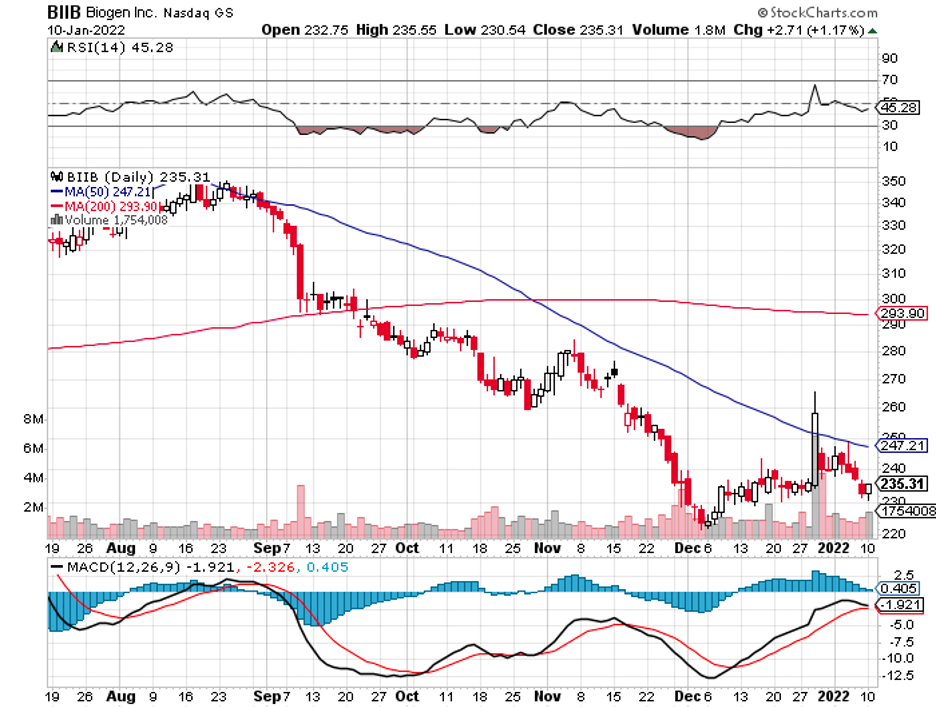Last year, talks that Samsung was in the process of making a $42 billion buyout bid for Biogen (BIIB) brought about a mixture of cynicism, hope, intrigue, and excitement over a potential agreement.
It was especially intriguing since the reported offer was roughly 20% more than Biogen's expected $35 billion projected value.
Eventually, this report was proven to be false.
But the mere fact that it garnered such traction and interest only highlighted Biogen’s seemingly debilitated state following their failure to deliver on a promised unprecedented motherlode following the controversial Alzheimer’s drug approval and lukewarm reception.
If you recall, experts expected Biogen’s Alzheimer’s drug, Aduhelm, to generate double-digit billions in sales considering its list price of approximately $50,000 annually and the roughly 5.8 million individuals diagnosed with the condition in the US alone.
Theoretically, Aduhelm’s addressable market was projected at $325 billion.
At that time, Aduhelm was anticipated to rake in at least $50 billion per annum—a projection that was reflected in the 55% increase in the company’s share price.
However, things didn’t go according to plan. Aduhelm’s accelerated FDA approval caused so much uproar that it eventually affected the drug’s marketability as well.
In an attempt to temper the protests, Biogen cut the cost of Aduhelm to almost half, with the drug priced at $28,000 annually instead of its original $50,000.
Despite this, the projected mega-blockbuster’s sales continued to disappoint, with its third-quarter earnings in 2021 only reaching a measly $300,000.
This January, though, Aduhelm might have a shot at saving redemption courtesy of a potential Medicare reimbursement scheme.
Ultimately, however, the decision to offer any form of reimbursement scheme will not only affect Biogen but all the Alzheimer’s disease treatments in the future.
This is actually one of the critical points that many people missed when Aduhelm gained approval.
In focusing too much on the share price of Biogen, they appeared to have misinterpreted the true purpose of the FDA’s decision.
Granting an accelerated approval for Aduhelm did not mean that the FDA was handing the company a chance to generate double-digit billions in sales.
What the agency intended was to demonstrate support for Biogen's thesis regarding a potential Alzheimer’s therapy.
That is, you can slow down the patients’ cognitive decline by aiming to reduce the amyloid-beta levels in their brains.
The FDA’s decision has, in effect, opened the floodgates not only for Biogen’s Aduhelm, but for all the other biotechnology companies working on the same idea.
To date, the companies developing their own Alzheimer’s disease treatment include Eli Lilly (LLY) with Donanemab and Roche (RHHBY) with Gantenerumab.
Both are expected to release results within the year or early 2023.
Other names are Anavex Life Sciences (SAVA) and Prothena (PRTA).
Outside its Aduhelm efforts, Biogen has also been developing new treatments, as demonstrated by the $4 billion investment it made on its R&D last year.
One promising candidate that can deliver blockbuster sales is its major depressive disorder treatment Zuranolone, which is a collaboration with Sage Therapeutics (SAGE).
Meanwhile, Biogen is also working with Ionis (IONS) to develop a successor for its spinal muscular atrophy treatment Spinraza.
Since this top-selling drug is expected to lose patent protection in 2023, the company has spent $60 million to come up with a new and more potent version: BIIB115.
For context, Spinraza recorded more than $2 billion in sales in 2021.
At this point, investor sentiment on the company has stooped at an incredibly low level. Unfortunately, the weak rollout of its Alzheimer’s treatment has planted suspicions regarding Biogen’s entire pipeline.
However, I think this kind of pessimism is quite misguided.
While the reality is that Aduhelm may never achieve the mega-blockbuster status it was once believed to reach, the situation shouldn’t necessarily diminish the truth that Biogen is actually performing quite well—and it will continue to do just fine.

